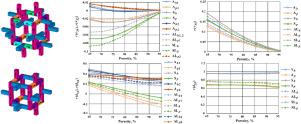Comparative analysis of piezoelectric regular foams from two types of Gibson–Ashby cells with uniform and piecewise homogeneous polarizations
IF 8.3
1区 材料科学
Q1 MATERIALS SCIENCE, MULTIDISCIPLINARY
引用次数: 0
Abstract
Modern achievements in the development of additive technologies allow the creation of highly porous piezoelectric metamaterials with a specified microstructure. Preliminary computer simulation of their properties depending on the initial geometric and physical data opens up wide possibilities in the design of effective piezoelectric devices with unique characteristics. Gibson–Ashby cells are classic versions of elementary structures of metamaterials and their mechanical properties are well studied. However, piezoelectric metamaterials have been investigated to a much lesser extent. Thus, for cells made of piezoceramics, it is fundamentally important to know the type of inhomogeneous polarization field. We investigated two types of canonical Gibson–Ashby cells: symmetric one with four connecting edges on each face and asymmetric one with two connecting edges on each face. Regular lattices can be composed of these cells, which were also studied. In addition, we compared the structures with uniform and with piecewise uniform polarization of piezoceramics. Effective moduli were found from numerical solutions of homogenization problems using the finite element method. The results obtained allowed us to identify the anisotropy classes of a homogeneous material for all considered variants and to establish the influence of geometry and polarization field on effective moduli. New unusual properties of effective transverse piezoelectric moduli, different from the properties of the corresponding piezoelectric moduli of conventional piezoceramics, were noted.


均匀极化和分段均匀极化两种Gibson-Ashby电池的压电规则泡沫的比较分析
现代添加剂技术的发展成就使具有特定微观结构的高多孔压电超材料得以创造。根据初始几何和物理数据对其性能进行初步的计算机模拟,为设计具有独特特性的有效压电器件开辟了广阔的可能性。吉布森-阿什比细胞是超材料基本结构的经典版本,其力学性能得到了很好的研究。然而,压电超材料的研究程度要小得多。因此,对于压电陶瓷制成的电池来说,了解非均匀极化场的类型是至关重要的。我们研究了两种典型的Gibson-Ashby细胞:对称的,每面有四个连接边,不对称的,每面有两个连接边。规则的晶格可以由这些细胞组成,这也被研究过。此外,我们还比较了均匀极化和分段均匀极化的压电陶瓷结构。利用有限元法对均匀化问题的数值解求出有效模量。得到的结果使我们能够确定所有考虑的变体均质材料的各向异性类别,并确定几何形状和极化场对有效模量的影响。指出了有效横向压电模量不同于传统压电陶瓷相应模量的新特性。
本文章由计算机程序翻译,如有差异,请以英文原文为准。
求助全文
约1分钟内获得全文
求助全文
来源期刊

Acta Materialia
工程技术-材料科学:综合
CiteScore
16.10
自引率
8.50%
发文量
801
审稿时长
53 days
期刊介绍:
Acta Materialia serves as a platform for publishing full-length, original papers and commissioned overviews that contribute to a profound understanding of the correlation between the processing, structure, and properties of inorganic materials. The journal seeks papers with high impact potential or those that significantly propel the field forward. The scope includes the atomic and molecular arrangements, chemical and electronic structures, and microstructure of materials, focusing on their mechanical or functional behavior across all length scales, including nanostructures.
 求助内容:
求助内容: 应助结果提醒方式:
应助结果提醒方式:


